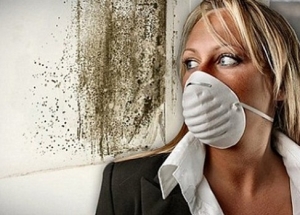The fight against mold always begins with the identification of the root causes of its formation and the subsequent removal of the contamination zone. Of course, such a struggle of positive emotions does not cause. How to get rid of the terrible mold in the bathroom?
Content
About mold
At the word "mold" the imagination paints an unpleasant picture: a cold, moist wall, constantly moist, in gray-white divorces with an unpleasant specific smell. B-r-rr-rr! Indeed, unaesthetic mold on the walls and ceiling of the bathroom can cause a lot of problems.
In most cases, we come across a so-called "black mold". Strains having a characteristic black color are pathogenic fungi. Under favorable conditions, hundreds of millions of spores are formed on one square meter of formed mold. These horrifying figures suggest that the only correct solution is the question: "How to remove mold from walls and ceiling."
The main reasons for the appearance of mold
Mold appears in conditions that are comfortable for its creation and reproduction. Depending on the air temperature and humidity in the bathroom, the room air constantly contains a certain amount of water vapor. Therefore, a potential source of creating mold conditions is:
• cast-iron water pipes, the place of collection of condensate
• lack of ventilation or insufficient ventilation
• cold and freezing walls
• leaking faucets.
However, the causes of the emergence of ubiquitous mold can be called abundantly, as they say, there would be an excuse. Mold can appear on the ceiling or walls, so the fight must begin immediately, after the discovery of the "hearth". A small peeling patch can turn over time into a region of considerable size that will affect not only the walls, but also the ceiling or vice versa. Everything depends on the degree of neglect of the problem.
Most often, mold is formed in the premises of the first and last floors, as well as in the bathrooms.
In the bathrooms, from the defeat of mold, the ceiling, walls, seams between tiles, and also silicone seals suffer.
If the mold begins to appear on the seams of ceramic and tiles, you can remove it with your own hands using hydrogen peroxide. Do this as quickly as possible, until the mold has penetrated the tile.
Methods of fighting with mold
There are numerous methods of combating mold: popular and radical.
folk methods
What are the popular methods of combating mold? As practice shows, folk methods of struggle are based on the use of various proven drugs: essential oils and extracts. With the words: "Shaitan-Maytan", the remedy is applied with the diminishing moon to the ceiling and walls of the bathroom. After 21 days, theoretically, the mold should disappear from the field of your vision and the bathroom. But the mold, which has disappeared for a while, appears again in time.
Therefore, radical methods of struggle are needed, especially since mold spores on the walls in the bathroom have already managed to penetrate the film of finishing materials. Now it's too late to think about why mold appears on the wall, and it's necessary to act.
The ceiling, walls and joints in the bathroom can be treated using chlorine bleach or a solution of copper sulfate.
However, the specific and poisonous smell of chlorine bleach and copper sulfate, the use of which has long been abandoned by European countries, will not solve the problem in principle. Such measures will be, alas, temporary, because microorganisms have become accustomed to such "enhanced therapy" and they, miasms, have already developed stable immunity.
radical methods
The most effective method of struggle is always considered to be revolutionary events. This means that you just need to make major repairs in the bathroom.
In this case, the wallpaper or tile is removed, and poorly washed whitewashing is washed off or washed off. Then the entire surface of the bathroom room is dried with a construction hair dryer and a primer containing a fungicidal solution is applied. Fungicidal solution, which is part of the primer, is intended for the destruction of microorganisms:
• Lichen
• Molds
• fungus
• moss.
When using a fungicidal solution, the color and gloss of the treated surface does not change, because the solution does not contain chlorine. The fungicide solution is intended for the treatment of any surfaces in rooms with high humidity. Types of treated surface:
• cement and cement plaster
• gypsum board and plasterboard
• concrete and concrete blocks
• Decoration Materials
• ceramic tile.
Recall that most of the building materials used to restore the bathroom, contain antiseptic in small quantities.
So, for example, in the grout for the seams Ceresit CE 40, there are components that have an antifungal effect - the formulas "MicroProtect".
Antiseptic primer with fungicidal additives ANTIPLESENE VAK-02-02 VAPA is used for treatment of affected and biologically contaminated molds and algae surfaces.
The primer is applied to the surface of the ceiling or walls using a roller or a flat brush and ensures the uniformity of the layer being treated.
Cleaning and washing probiotics
To get rid of mold in the bathroom is supposed to be possible, using preparations washing probiotics combined by the concept of cleaning.
Cleaning for the bathroom is not difficult even for those who have never encountered this. In order to smell clean and shiny bathroom, including walls, floor, ceiling and soap dishes, simply use foam-forming sprays capable of destroying mold, germs and viruses. To this end, the joints between the tiles are processed using an antifungal agent.
Unpleasant odors, formed in the bathroom, are perfectly removed with the help of sprays with active bioenzymes. Calcium salt deposits, including components of mold and microspore, require in this case the use of an acidic cleaner with properties (pH = 0.5). Therefore, cleaning using detergents with probiotics cleans the bathroom surfaces at the microbiological level.
http://www.youtube.com/watch?v=AAWMD3a3hAg































